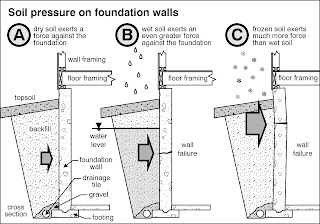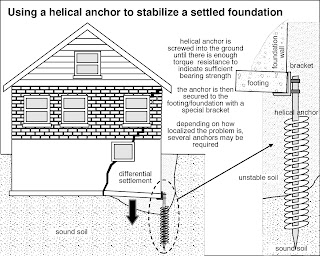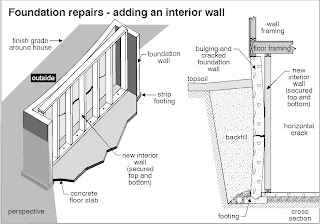Foundation Cracks
Cracks in your foundation can be a serious defect, or they can of no real concern - so how do you tell the difference? What's kind of issue is going to end up really costing you? Hopefully the following will help you recognize the difference when looking at your own home, or one you propose to buy.
As concrete dries it shrinks, which often causes small cracks along the foundation, commonly known as hairline cracks. The faster the concrete dries, the more it shrinks. The higher the water content in the mix, the more it shrinks. It's going to happen to young and old homes alike, so don't feel too concerned about the small cracks running along the foundation of your newly-built house.
These shrinkage cracks normally develop at windows, doors, beam pockets or other penetrations. Usually these hairline cracks, no
bigger than the thickness of a dime and no cause for concern. They're relatively unavoidable, and are the most common type of crack, almost every home is going to have them.
Larger cracks may or may not be a concern but should be checked by a qualified individual. The Alberta New Home Warranty Program Performance Guide states: “Cracks are not unusual in concrete foundation walls. Such cracks greater than 1/8 inch are considered excessive.”
Well that's good to know - right? Most often the cracks in your home won't cause you much grief. So which ones will?
The main concern is Structural Movement in the foundation.
If
there is displacement, the concrete will be uneven from one side of the
crack to the other. This movement usually indicates external pressure
on the foundation wall, which must be investigated, or it could be that
the wall was damaged during construction. Older buildings are more susceptible to this time of crack, but poor construction or architectural design could be at fault. Sometimes it could've been a bad home renovation or as serious as decay.
Horizontal
cracks in a foundation are more uncommon but can be stabilized without
major expense as long as the cause is not ongoing and there has not been
large displacement in the foundation.
There are a number of factors that will cause horizontal cracking or movement.
Backfill heights:
Backfill is a type of water drainage placed around your home's foundation. Overfilling this can cause pressure and form horizontal cracks.
Frost, heavy traffic and tree roots:
Overgrown roots and overloaded vehicles can cause pressure on your foundation.
Movement in the foundation can be caused by
any number of factors. Larger type cracks in foundations are caused by
settlement in the footings or pressures from below forcing the footings
up or pressures from the outside of the foundation. Foundation walls
(footings) that have heaved upwards are caused by inadequate frost
protection for the footings or expansive soils.
A high clay content in the soil below the
footing, together with water can cause extreme damage to foundations.
The source of the water must be found and eliminated.
The amount of movement and age of the structure should always be taken into consideration.
Some examples for foundation movement are as follows:
Soil types and water pressure:
Certain soil types may be looser or have inadequate water drainage. If your home is settled on various different soils, it may not sink evenly and part of your home may begin breaking due to the uneven surfacing.
Frost pressure, Lot Configurations and Excavation Differences:
Movement in a foundation wall is usually more serious and should always be analyzed by a professional.
Common Foundation Repairs
These types of repairs need to be designed
and approved by a person specializing in foundation repairs preferably a
structural engineer. These repairs can be quite costly.
Wall or Footing Settlement
Mud jacking or hydraulic jacking and under
pinning of the footing may be required to stabilize the foundation that
is dropping or settling.
Displaced foundation wall cracks may need to be reinforced or stabilized.
The vast majorities of foundation cracks are
of no concern, but should be investigated and reported on by an expert.
The expert’s written report is not only important for your purchase and
peace of mind, but to show to a future buyer when you sell so that you, nor your possible future buyer are investing in hidden risks.
We hope this helped you understand a little bit more about your home, new or old, and will prepare you for the future you have together!












Calgary Home Inspections Insight And Advice: Cracks - How You Can Recognize Serious Damage In Your Foundation. >>>>> Download Now
ReplyDelete>>>>> Download Full
Calgary Home Inspections Insight And Advice: Cracks - How You Can Recognize Serious Damage In Your Foundation. >>>>> Download LINK
>>>>> Download Now
Calgary Home Inspections Insight And Advice: Cracks - How You Can Recognize Serious Damage In Your Foundation. >>>>> Download Full
>>>>> Download LINK 46